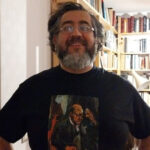For Carmen, who made me read Octavio Paz again.
For Marcelo, Enoc, and Gonzalo, when we read
Libertada bajo palabra in the hallways of the U.
*
It’s hard to remember, but at the end of the eighties, those of us who were starting to feel our way into poetry in Chile were faced with a confusing landscape, somewhere between distressing and monotonous. Perhaps like many teenagers and young adults of Spanish America, lost in provincial cities, having passed through secondary school in provincial institutes, only lucky enough, perhaps, to study letters at the only provincial university that remained in the capital of that same province, our fate was to try to reconstruct a cultural and poetic memory that looked fragmentary and strained, at best, discontinuous between high flown and, truly, unfamiliar names. Neruda sounded monumental and distant with his mellifluous voice, Huidobro was an astronaut lost in a galaxy we didn’t dare to make our own, Rojas was about to enter into massive circulation, in those years he was still a sneaky eccentric whose music would only later captivate us, and Parra, with his consummate writerly histrionics, skillfully made us feel, in the zeal of the apprentice poet, as if part of a cruel, grinning variation by López Velarde: tacky and reactionary. None of that changed much at the start of the nineties. The Chilean university, in general, in spite of still being imbued with the heady happiness of having defeated the Dictator at the polls just a couple of years before, was far from an incentive promising the return or establishment of a Parnassus. It was well known in hallways and bar conversations that, if you liked literature, and even more if you dared to write poetry, the most inhospitable place, where you were likeliest to lose all interest in them, was studying at the Institute of Letters of the Catholic University of Valparaíso. Among outmoded social groups with their melancholy Andean music and the indolent tomes that made up the manuals of Latin or Literary Theory, many students had either given up or stepped forward as “poets” on some night of happy revelry. Perhaps the endgame of any naïve teenager was to forsake poetry—which had hardly been promised to him—in pursuit of an alcoholic port of call or a disenchanted fever upon trying to read the Russian formalists?
*
Liza López Fernández was my classmate in the old Literary Theory Seminar II: a true garbage dump where they dropped off the failures from previous seminars, the novices, and those who looked, in the eyes of any teaching assistant, either simple or tiresome. Maybe I was all of those things and I hadn’t yet realized. However it was, my classmate, a little eccentric with her makeup, her dressy feathered hats, and her dazzling dress, surely wished in secret to be la Maga from Hopscotch, given her way of answering the occasional questions of the professor or assistant with enigmatic verses, often in French or in Catalan. The laughs she got from all of us were only comparable to her inmutable histrionics, turning a deaf ear to all that and more, to looking at us with an intense sarcastic smile: the smile of someone who knows she’s different. The Seminar focused on subjects of Poetics. Only a “yahooo” from Liza pulled me, somewhat startled, out of my self-absorption. Before the start of the next class, standing on a desk, she read aloud a strange text. Obviously, my classmates thought nothing of responding with mocking laughter, but she, valiantly playing I’m not sure which role, carried on reading unscathed. In the end, angered by our indifference, she walked out of the room, not before blurting out an incomprehensible word, maybe in Swedish or Provençal. The fact is, I’m not sure how, but I found myself talking to her in the hallway. Her eternal smile had sunken into the most absolute seriousness: “You’re all beasts.” Shy, I asked her, risking a slap, what she had been reading aloud in the classroom. “It was Octavio Paz, the first paragraph of The Bow and the Lyre.” I told her I found it very beautiful. “I’m sure,” she responded. “And that’s how Octavio is. As a matter of fact, he and I have a pact to ritually cleanse these horrendous Poetics classes where nobody knows anything about poetry.” I looked at her perplexed. “Of course,” she blurted out, “perhaps you think any true poet could be happy in this gloomy place?” Her answers only left me more confused. But also full of a curiosity that made me go more often than usual to the grimy library.
*
After that conversation, I looked compulsively for Paz’s book. When I started reading it, a whole world came down on top of me: it was a true revelation. Past the initial enthusiasm, and with the serenity provided by time and distance, I think the first thing that surprised me about Paz—or at least what I remember surprised me at the time—was the agility of his prose: an ability to make words dance to an enveloping rhythm. A prose becoming categorical in its opinions and sometimes in its conclusions, not without offering its reader a thousand opportunities to disagree, ripples between long and short periods, with scarce interjections, with ever-pertinent digressions: proof positive of any good essayist who doesn’t preach the truth, but smooths paths of understanding for you and takes you by the hand to guide you toward spacious, serene, or rough lands, always sure to make you feel safe. A prose that doesn’t invite you to pause, but rather to believe in your own certainty as a reader. A certainty in any case established with the certainties that this very prose provides, through the entryways it subtly elaborates. So, without realizing it, you end up at the first stage, literally enchanted, where this enchantment implies realizing that Paz, as a prose writer, has led you to his own territory: a territory it will not be easy to leave. But that experience comes later. At the first moment, you don’t want to escape his spell, and you feel a desire to go deeper into the country he proposes to you: to wander across its valleys, its heights, its precipices, its oceans, its skies of intensity and suggestion. This means a reader capable of accepting his invitation wishes to read his books one after another. That’s what I did, at least. As soon as I finished The Bow and the Lyre, I carried on with Children of the Mire. Years later with The Other Voice. Anyone who has read this “trilogy” of true poetic theory will conclude that if, in several passages, Paz is a repetitive author, that repetition does not clash with thought that seeks to show itself, again and again, as original. Not at all. This is thought unafraid to put forth, once again, its own convictions, perhaps as an act of self-convincing that its insecurities do not stand out and are never solved. The absolutism of an obstinate opinion is the furthest thing from Paz. But the other thing that surprised me about Paz, on a second occasion, is the diversity of his reflection: few things lay beyond his curiosity. This is something typical of the Spanish American intellectual who shies away from specialization. Everything moves him, assails him, and influences him. From painting and politics (there are Los privilegios de la vista [The privileges of sight], One Earth, Four or Five Worlds, and El ogro filantrópico [The philanthropic ogre] to prove it), to history and art criticism (where Puertas al campo [Doors to the field], Convergences, and Sombras de obras [Shadows of works] are primordial), to geography and imagination (with In Light of India and La búsqueda del comienzo [The search for the beginning] as touchstones) to the mass media and the most abstruse theories of contemporary semiotics (with El signo y el garabato [The sign and the scrawl] and Claude Lévi-Strauss o el nuevo festín de Esopo [Claude Lévi-Strauss or the new feast of Aesop] as a background). Paz’s curiosity, without a doubt, is not gratuitous. He has a social, cultural, and political interest in investigating things, discourses, and actions, for the sake of an answer to or, at least, a clarification of the eternal questions of the Spanish American intellectual: Who are we? Can we really be “modern”? But beyond these interrogations that go hand in hand with a wide-ranging erudition camouflaged with charming rhetorical courtesy, with tact and mastery, these vast reflections leave few spaces empty or subjects incompletely addressed, as they can only be understood, in my humble opinion, if we take them as they truly are: opinions that are enthusiastic, but densely critical, sometimes spur-of-the-moment and sometimes quite seductive and convincing in their elaborate and precise arguments, in what is, certainly, a complex emotional and mental process convening not only an astonishing quantity of facts, but also a unique ability to assimilate these facts and references around a wide-awake, well-ordered sensibility, a sensibility molded by imagination and a persistent perspicacity that seeks, again and again, to mediate our perspective of the wonder it puts forth, spellbound. This “manner,” so characteristic of Paz, less than a mechanism to be rationally accepted, shows itself more as a peculiar state of mind that only a poet like him could accept and implement from essay to essay, from text to text. So, without a second thought, one of the things that Paz, as an author, leaves branded on his readers is, without a doubt, the mark of confronting what a poet can think and say about the world. And that’s no small thing.
*
I always heard, among friends, colleagues, and learned people, that Paz wasn’t a brilliant poet, that he wasn’t “spontaneous,” that he always had to put on the mask of the “noble savage” in order to hide his ostentatious erudition that kept him from walking gracefully along the slippery floor that is poetry in Spanish. But, where so many have seen weakness and even defect, I dare to see virtue. Paz incarnates the tragedy of the Spanish American and modern poet: the poet who feels an immense longing for the immediacy of life, all of whose verses move with the desire to clarify his own passion, his own daydream, his own desire. A poetry of feeling intelligence. And maybe that makes him, in our language, a heterodox poet. Not in vain, his admiration for Darío, Cernuda, Pessoa, and Eliot is the admiration of a poet who sees his reflection in those poets who have tried to make of language an incarnation not only of the emotional and the immediate, but also of the remembrance of an experience lost in the most remote nook of modernity: that reconciliation of contrasts that is seldom attained, that takes the body and intelligence as its primordial reference points. Perhaps for this reason, his extreme defense of surrealism may sometimes seem “démodé,” perhaps even a little simplistic. No matter: this is in the very center of his poetic obsession with conjuring up presence in a disenchanted world from which God has fled. For Paz, this presence has a name: sometimes it’s the woman with her secrets as an incarnation of that which is radically other, other times it’s the utopia of the revolution as an epochal sign of a need to be convinced that a better society is possible, still other times it’s a question into the stellar void in which the astonished gaze of the poet asks, like Darío, about the enigma of the constellations and tries to translate the question into the poem he means to write.
*
As a Spanish American, Paz, with the passage of time, also teaches you not to feel cut adrift. A large part of his instruction as a poet, reader, and essayist is meant to point out references, markers, road signs disguised as personal tastes that, in the end, are intense refuges that you can choose whether or not to accept, but that you’ll rarely turn down. They are gestures, invitations to make you feel you are part of something. I’m not entirely sure if this could be seen as the elaboration of a tradition, a canon, or a map. I don’t know. I can only speculate that the reception of Darío and the modernists, of the Spanish poets of the Generation of ‘27, of the heroes of the avant-garde—Apollinaire, Huidobro, Bretón, Tzara, Vallejo, but also Picasso, Ernst, and Duchamp above all—or of their peers from other parts like Pessoa, Pound, Cage, or Ungaretti, would be very different to the one Paz helped us to construct and imagine: a more dispersed and fragmented reception, without coherence, without the happiness of seeing a wide face smiling at you with every look. Without a doubt, many have seen this same coherence as suffocating, overwhelming, and even “repressive.” That’s for sure. Could a poet like me object to that? But what powerfully calls my attention is that, without reading Paz, without his generous indications of names, works, and relationships, above all without that coherence that provided us with an impassioned order of meaning that never feared contradiction, without the leveling of that stony path that is writing a poem in our language and on our continent, many of us would have taken too long to find ourselves—if something like that is even possible in our time. Without Paz’s work, even its arbitrary moments, we would have had to wander until stumbling, for the nth time, like our modernist great-grandparents, upon the lost path through the forest. That path that, since the nineteenth century and throughout the twentieth, every Spanish American poet has had to walk down, whether toward Paris, New York, the Far East, or the borders of an imaginary country with no center or edges. That path has become necessary again and again in order to be “absolutely modern,” even if we wish to oppose, from any trench, that very modernity or the agony of its cultural anxiety that so overwhelms us today. Yes, I have a feeling that the path would have been more torturous, perhaps we would have discovered the dust again, perhaps language would not have been so ready for our exploration. At any rate, from the province—that gigantic no man’s land that is so much our own, so ours on this continent crossed by contradictions—where every poet feels at ease or on the edge of desperation or both at once, Paz offers a helping hand and a slap on the back for our internal insecurities, even when the glamour of marginality, with its supposed alternative prestige, becomes an irritating, “mainstream” feeling that gives us more and more vertigo the deeper we sink into it.
*
Years have passed. I never heard of Liza and her charming eccentricity again. I kept in touch with very few of my old classmates from university. Some left poetry behind. Others dedicated themselves to various other jobs and vocations. Some stayed in the academic world, others continue as secret poets with secret writing. I myself am very different from the young man I was thirty years ago. But, either way, the maps of reading that Paz prodigiously provided, that guided us in our first youth and in that creative crisis every poet suffers between thirty and forty—or, perhaps, almost his whole life—are still there. They are maps to be scratched out, rewritten, and laid out in new orders. They are maps to be, in the end, subverted; it couldn’t be any other way. But they are also the whisper of the old friend from fond memories who returns again and again to ask about you and your business, the friend who comes back unabashedly to remind you of that name you forgot, that verse you read or that image that opened new worlds to you years ago. But they are also a possibility: the possibility of letting you know that in that map is nested the invitation to set out, once again, on a journey that promises to draw you out of yourself. Like when you were eighteen years old and Rimbaud walked before you on his adventure in Abyssinia.
Ismael Gavilán Muñoz
Quilpué, Chile,
Spring 2018
Translated by Arthur Dixon



